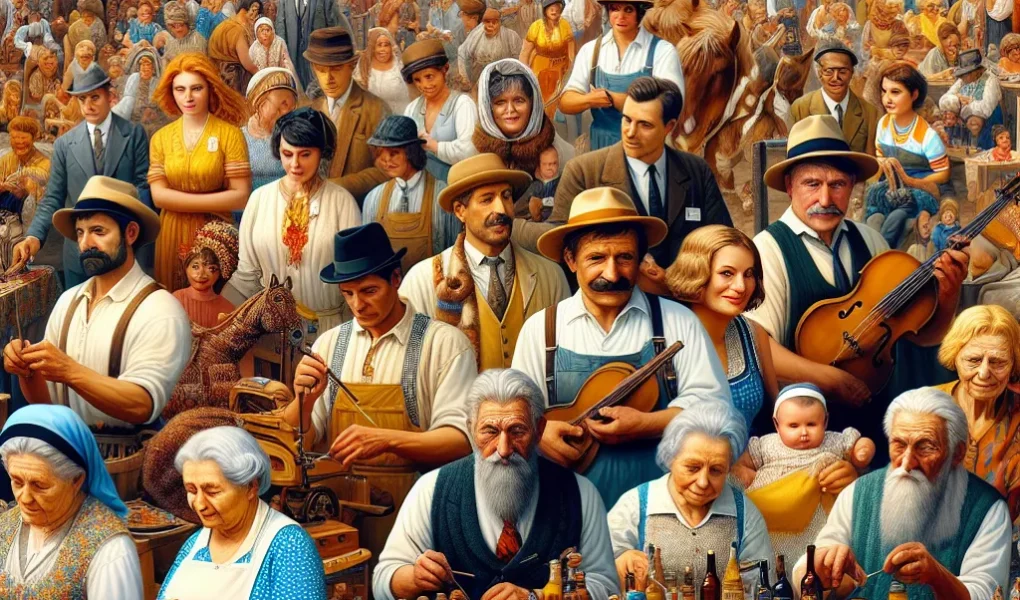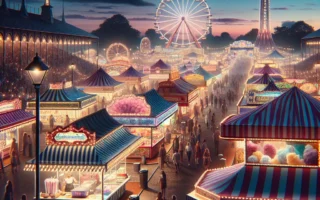The History and Significance of Traditional Fairs
Traditional fairs have been an integral part of many cultures for centuries, serving as important social, cultural, and economic events. These fairs, often rooted in historical traditions and customs, hold significant importance in the collective memory of communities around the world. The history of traditional fairs can be traced back to medieval times, when they were essential for trade, commerce, and social interaction. Over time, traditional fairs have evolved to encompass a wide array of activities, including entertainment, food, crafts, and agricultural displays.
The significance of traditional fairs extends beyond mere entertainment, as they play a crucial role in preserving cultural heritage and fostering community spirit. These events often showcase local traditions, skills, and craftsmanship, serving as a platform for artisans and vendors to display their wares and talents. Additionally, traditional fairs offer an opportunity for intergenerational exchange, where knowledge and customs are passed down from one generation to the next, contributing to the continuity of cultural practices.
Understanding the historical and cultural significance of traditional fairs is paramount in their revitalization in a changing landscape. By recognizing the enduring legacy and value of these events, communities can develop strategies to ensure their preservation and relevance in the modern era. Embracing the history and significance of traditional fairs can serve as a foundation for successful revitalization efforts, appealing to both local residents and visitors seeking an authentic cultural experience.
Adapting to Modern Trends: Challenges and Opportunities
Revitalizing traditional fairs in the modern landscape presents both challenges and opportunities. Adapting to modern trends is essential for the success of these events as they strive to remain relevant and attractive to a contemporary audience. One of the key challenges in this process is striking a balance between preserving the traditional essence of fairs while incorporating modern elements to meet evolving consumer preferences.
Embracing technology is an important aspect of adapting to modern trends. Implementing online ticketing systems, mobile apps for event information, and digital marketing strategies can significantly enhance the accessibility and visibility of traditional fairs. This adaptation not only caters to the tech-savvy demographic but also opens up new promotional avenues to reach a wider audience.
Furthermore, traditional fairs can capitalize on the growing interest in sustainable and eco-friendly practices. Incorporating environmentally conscious initiatives such as reducing plastic waste, promoting local artisans and organic vendors, and emphasizing eco-friendly transportation options can appeal to the modern consumer’s desire for ethical and sustainable experiences.
Despite the challenges, adapting to modern trends presents an array of opportunities for traditional fairs. By embracing technology and sustainability, these events can position themselves as forward-thinking and relevant, attracting a new generation of attendees while preserving the cultural heritage and authentic charm that makes traditional fairs so appealing.
Community Engagement and Local Support
In the context of revitalizing traditional fairs, community engagement and local support play a pivotal role in ensuring the success and sustainability of these events. Embracing the rich heritage and cultural significance of traditional fairs, organizers can leverage community engagement as a powerful tool to foster local support and participation. Through actively involving the community in the planning and execution of the fair, organizers can create a sense of ownership and pride among local residents, encouraging them to actively participate and support the event. This can be achieved through various strategies such as organizing community meetings to gather input and ideas, involving local artisans and businesses, and collaborating with local schools and organizations.
Furthermore, promoting the fair as a celebration of the community’s heritage and traditions helps to instill a sense of pride and identity among residents, fostering a collective commitment to the success of the event. Local support can also be cultivated through strategic partnerships with businesses, sponsors, and community organizations. By highlighting the economic and cultural benefits that the fair brings to the local area, organizers can rally support from local businesses and stakeholders, securing funding, resources, and promotional support.
In conclusion, community engagement and local support are integral to the revitalization of traditional fairs. By actively involving the community, promoting local pride and identity, and fostering strategic partnerships, organizers can ensure the success and long-term sustainability of these culturally significant events in a changing landscape.
Showcasing Traditional Crafts and Artistry
Revitalizing traditional fairs requires a delicate balance of preserving heritage while adapting to the changing landscape. Showcasing traditional crafts and artistry is a pivotal aspect of this revitalization effort. By highlighting the craftsmanship and artistry of traditional crafts, fairs can attract a new generation of visitors while preserving and celebrating cultural heritage.
Traditional fairs can leverage the showcasing of traditional crafts as a strategy for success. By providing artisans with a platform to display their skills and products, fairs can promote the value of traditional craftsmanship. This not only contributes to the preservation of cultural heritage but also provides economic opportunities for artisans.
Integrating traditional crafts into the fabric of the fair can enhance the overall visitor experience. Workshops and demonstrations can offer attendees a firsthand look at the intricate processes involved in traditional crafts, fostering a deeper appreciation for the artistry and skill involved. Additionally, creating marketplaces where artisans can sell their goods can contribute to a vibrant and dynamic atmosphere, attracting visitors eager to explore and purchase unique, handcrafted items.
In a changing landscape where modernization often overshadows tradition, the showcasing of traditional crafts at fairs serves as a powerful means of connecting the past with the present. By embracing and promoting traditional crafts and artistry, fairs can carve out a distinct identity, attracting both local and international visitors who seek authentic cultural experiences.
In conclusion, showcasing traditional crafts and artistry at traditional fairs is a compelling strategy for success in this changing landscape. By placing emphasis on the heritage, skill, and artistry of traditional crafts, fairs can attract a diverse audience, support local artisans, and preserve cultural traditions for future generations.
Innovations in Entertainment and Attractions
Traditional fairs have been an integral part of many cultures for generations, but in today’s rapidly changing landscape, it’s essential to revitalize these events to ensure their continued success. One key aspect of revitalizing traditional fairs is through innovations in entertainment and attractions. By incorporating modern entertainment elements while still honoring tradition, fairs can appeal to a wider audience and stay relevant in an increasingly competitive environment.
Innovations in entertainment and attractions can take many forms, from introducing new and exciting rides to incorporating interactive experiences that engage attendees of all ages. For example, integrating virtual reality experiences or hosting live music performances featuring both traditional and contemporary artists can add a fresh and dynamic element to a traditional fair. Additionally, interactive workshops, demonstrations, and competitions showcasing traditional crafts and skills can provide a hands-on and educational experience for attendees, bridging the gap between old and new.
Furthermore, embracing technological advancements such as mobile event apps or digital scavenger hunts can enhance visitor engagement and provide a seamless way to access information about attractions, schedules, and interactive maps.
By integrating these innovative entertainment and attraction elements, traditional fairs can adapt to the changing tastes and expectations of attendees while preserving the cultural heritage and spirit of the event. These strategies not only attract new visitors but also encourage the continued participation of existing attendees, ensuring the longevity and success of traditional fairs in a rapidly evolving world.
Future Prospects and Sustainability in a Dynamic Market
In the dynamic market of traditional fairs, the future prospects and sustainability are crucial considerations for successful revitalization strategies. As consumer preferences and behavior continue to evolve, traditional fairs must adapt to remain relevant and appealing. One promising avenue for ensuring the sustainability of traditional fairs is embracing innovation while preserving core traditions. By integrating modern elements such as digital marketing, online ticketing, and interactive experiences with traditional aspects like local crafts, folklore, and culinary delights, fairs can attract a wider audience while retaining their cultural essence.
Another key aspect of ensuring future prospects and sustainability is community engagement and collaboration. Traditional fairs can form partnerships with local businesses, artisans, and community organizations to foster a sense of belonging and shared ownership. This not only supports the local economy but also enhances the fair’s appeal as a communal gathering that celebrates heritage and craftsmanship. Moreover, investing in sustainable practices such as eco-friendly infrastructure, waste reduction, and energy efficiency can position traditional fairs as responsible stewards of the environment, aligning with the values of contemporary consumers.
Furthermore, embracing diversity and inclusivity is instrumental in securing the future of traditional fairs. By showcasing a wide range of cultural traditions, performances, and products, fairs can attract a diverse audience and promote cross-cultural understanding. Additionally, offering accessible facilities and programming ensures that traditional fairs are welcoming to all individuals, regardless of their background or abilities. This commitment to inclusivity not only broadens the appeal of fairs but also contributes to their long-term sustainability by fostering a positive and inclusive community image.
In conclusion, the future of traditional fairs in a dynamic market relies on their ability to adapt, innovate, and engage with their communities. By embracing modernity while preserving traditions, forging local partnerships, prioritizing sustainability, and promoting inclusivity, traditional fairs can position themselves for long-term success and relevance in an ever-changing landscape.



